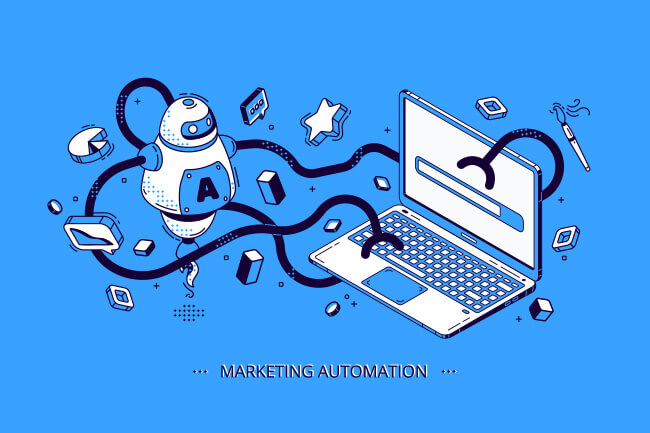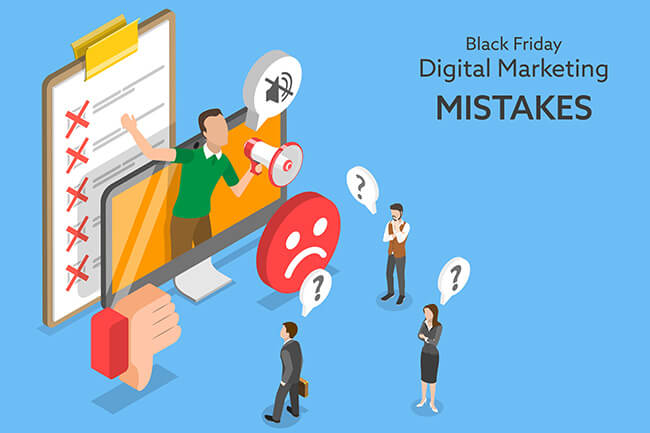Marketing automation is like having a helpful robot assistant for your marketing tasks. It’s a set of tools and software that helps businesses do their marketing more efficiently and effectively.
Here are some examples:
- Email Marketing: Imagine you want to send personalized emails to thousands of customers on their birthdays. With marketing automation, you can set up a system that automatically sends these birthday emails without you having to do it one by one.
- Lead Nurturing: Suppose someone visits your website and signs up for your newsletter. Marketing automation can track this person’s actions and send them follow-up emails with more information or special offers based on what they looked at on your site.
- Social Media Posting: You want to post updates on Facebook, Twitter, and Instagram every day, but you’re too busy. Marketing automation tools can schedule and publish these posts at the right times, even when you’re not online.
So, why use marketing automation?
Well, marketing teams have one main mission: make more money. To do this, they need tools to:
- Work smarter together.
- Connect better with customers.
- Make customers really happy.
- Do less boring stuff.
- Catch more potential customers.
That’s why they like marketing automation software. Here are some specific things they want:
- 35% want to make marketing and sales work together better.
- 34% want to get customers more interested.
- 34% want customers to have a great experience.
- 30% want to stop doing so many boring tasks.
- 28% want to find more people who might become customers.
What is Marketing Automation?
In essence, marketing automation simplifies repetitive marketing tasks, helps you reach your audience at the right moments, and allows you to provide a more personalized experience to your customers. It’s like having a marketing helper that works 24/7, so you can focus on other important aspects of your business.
Benefits and Importance of Marketing Automation
Marketing automation offers numerous benefits that can significantly impact a business’s efficiency and effectiveness.
Here are some key points highlighting its importance:
- Time Efficiency: Marketing automation reduces manual tasks, such as sending emails and posting on social media, saving a lot of time for marketing teams.
- Consistency: It ensures that your marketing efforts, like sending messages or posts, are consistent across different channels and at various times.
- Personalization: Automation tools can segment your audience and send personalized messages, increasing engagement and customer satisfaction.
- Lead Nurturing: Automation helps in nurturing leads by sending them relevant content at the right time, increasing the likelihood of conversion.
- Scalability: As your business grows, automation allows you to handle a larger audience without a proportional increase in manual effort.
- Data-Driven Insights: It provides valuable data and analytics, helping you understand what works and what doesn’t in your marketing campaigns.
- Improved Customer Experience: Automation ensures timely responses to customer inquiries, leading to better customer satisfaction.
- Cost-Effective: While there’s an initial investment, automation can save money in the long run by reducing the need for manual labor.
- Lead Generation: Automation tools can capture and qualify leads, making it easier to identify potential customers.
- Sales and Marketing Alignment: It helps bridge the gap between sales and marketing teams by ensuring that leads are nurtured until they’re ready to make a purchase.
- Multi-Channel Marketing: Automation can manage marketing efforts across various platforms like email, social media, and websites, ensuring a cohesive brand presence.
- Competitive Advantage:Businesses using marketing automation often stay ahead of competitors who rely on manual marketing methods.
How Does Marketing Automation Revolutionize Businesses?
Marketing automation has the power to revolutionize businesses by significantly improving efficiency, enhancing customer engagement, and driving revenue growth. Here are some key ways in which marketing automation can bring about this transformation:
- Efficiency Boost: Marketing automation streamlines repetitive tasks, allowing marketing teams to focus on more strategic activities. This can result in time and cost savings.
- Personalization at Scale: Automation enables businesses to deliver highly personalized messages and offers to individual customers or segments, increasing the relevance of marketing campaigns.
- Lead Nurturing: Businesses can nurture leads through automated email sequences and content delivery, ensuring that potential customers receive timely and relevant information, ultimately increasing conversion rates.
- Behavioral Tracking: Automation tools can track customer behavior, helping businesses understand their interests and preferences, which can be used to tailor marketing efforts.
- Multi-Channel Marketing: Marketers can manage and coordinate campaigns across various channels (email, social media, website) from a single platform, ensuring a consistent and coherent brand message.
- Improved Analytics: Marketing automation provides detailed analytics, allowing businesses to measure the performance of campaigns, identify what works, and make data-driven decisions.
- Sales and Marketing Alignment: Automation can facilitate better communication and alignment between sales and marketing teams, ensuring leads are effectively handed off and nurtured.
- Customer Segmentation: Businesses can segment their audience based on various criteria, allowing for highly targeted marketing efforts and improved customer engagement.
- Scalability: As businesses grow, marketing automation tools can scale with them, accommodating larger customer bases and more complex marketing strategies.
- Drip Campaigns: Automated drip campaigns can guide customers through the sales funnel, providing them with relevant content and incentives as they progress toward a purchase decision.
- Lead Scoring: Automation tools can assign scores to leads based on their behavior and interactions, helping sales teams prioritize their efforts on the most promising prospects.
- Cost-Effective Advertising: Automation can optimize advertising spend by targeting the right audience segments and adjusting campaigns in real-time.
- Customer Retention: Automation is not just about acquiring new customers; it can also help businesses engage with existing customers, improving retention rates.
- 24/7 Availability: Automation allows for round-the-clock engagement with customers, even when the marketing team is not working.
- Compliance and Consistency: Marketing automation ensures that marketing efforts comply with regulations and maintains brand consistency.
Key Concepts of Marketing Automation
Let’s break down the key concepts of marketing automation in simple terms:
- Automation: Marketing automation is like having a helper robot that does repetitive marketing tasks for you automatically. It saves you time and effort.
- Emails and Messages: It helps send emails and messages to the right people at the right time. For example, it can send a welcome email to new customers or a birthday offer to loyal ones.
- Personalization: Marketing automation makes messages more personal. It’s like a store owner who remembers your preferences and suggests things you might like.
- Lead Nurturing: Imagine you’re fishing. Automation helps you catch more fish by sending follow-up messages to people who show interest in your product or service.
- Data and Insights: It collects data on how people interact with your messages. It’s like knowing which fishing bait works best. This data helps you make smarter marketing decisions.
- Multi-Channel: It works on different platforms like email, social media, and websites. It’s like having one tool to manage all your fishing gear.
- Scalability: As your business grows, marketing automation grows with you. It’s like having a bigger net as you catch more fish.
- Time and Cost Savings: Automation is like having a super-efficient employee who works 24/7 without getting tired. It saves you money and helps your business grow.
Top Marketing Automation Tools And How To Select Right One For Your Needs?
Depending on your marketing needs, different tools can help you.
Here are some tools for various strategies:
1. Omnisend (Email Marketing):
What It Does: Helps online stores send emails and SMS to customers.
Benefits: Easy-to-use, combines email and SMS, and tracks campaign performance.
Price: Starts at $16 per month for 500 contacts.
2. Refersion (Affiliate and Influencer Marketing):
What It Does: Helps with affiliate and influencer marketing.
Benefits: Finds affiliates and influencers, tracks results, and manages payments.
Price: Starts at $99 per month for tracking 50 conversions.
3. Trellis Corporation (E-commerce Marketing):
What It Does: Uses AI to optimize e-commerce strategies.
Benefits: Improves ad placement, product content, and pricing.
Price: Starts at $299 per month.
4. Iconosquare (Social Media Analytics):
What It Does: Provides analytics for social media campaigns.
Benefits: Tracks performance, automates reporting, and supports multiple platforms.
Price: Starts at $59 per month for three social profiles.
5. Find Your Influence (Influencer Marketing):
What It Does: Streamlines influencer marketing campaigns.
Benefits: Finds influencers, manages campaigns, and tracks results.
Price: Starts at $199 per month.
Building Your Marketing Automation Strategy
Building your marketing automation strategy is like planning a road trip and partnering with the right Digital Marketing Agency will make all the difference. You need to know where you’re going and how to get there.
Here are the simple steps:
- Set Your Goals: Decide what you want to achieve, like more sales or better customer engagement. It’s like choosing your destination.
- Know Your Audience: Understand who your customers are and what they like. It’s like knowing who’s coming on the trip.
- Choose the Right Tools: Pick the automation tools that fit your needs, like email or social media automation. These are like the vehicles you’ll use on your trip.
- Create Content: Make messages and content that your audience will like. It’s like packing the right things for your journey.
- Automation Setup: Set up your tools to send messages automatically. It’s like programming your GPS to follow a route.
- Testing: Try your automation to see if it works well. It’s like a test drive before your trip.
- Monitor and Adjust: Keep an eye on how your automation is doing. If it’s not working, adjust it like changing your route if you get lost.
- Measure Success: Check if you’re reaching your goals, like seeing if you’ve reached your destination.
- Improve Over Time: Learn from your journey and make your automation better for the next one.
Measurement And Analytics In Marketing Automation
Measurement and analytics in marketing automation are like checking how well your marketing is doing. You collect data about what’s happening, analyze it to understand what’s working and what’s not, and use that information to make your marketing better. It’s like keeping score in a game and adjusting your strategy to win.
Here’s a simple breakdown:
- Track Everything: Just like keeping score in a game, you track how your marketing is performing. This includes things like how many people open your emails or click on your ads.
- Data Collection: You gather lots of data, like who your customers are and what they like. This is like keeping stats on each player in a game.
- Analyze the Data: You look at the data to see patterns and trends. It’s like studying game footage to understand your team’s performance.
- Measure Success: You figure out if you’re winning or losing. Are your marketing efforts bringing in more customers or making more sales? This is your scorecard.
- Make Changes: If you’re not winning, you adjust your strategy. It’s like changing your game plan during halftime to improve your chances of winning.
- Continuous Improvement: You keep using data to get better. Just like a sports team reviews plays to improve, you use analytics to make your marketing more effective.
Common Challenges In Marketing Automation And How To Overcome Them
Let’s break down the common challenges in marketing automation and how to overcome them in simple terms:
Common Challenges in Marketing Automation:
- Complexity: Sometimes, marketing automation tools can seem complicated.
- Data Quality: Bad data can lead to mistakes in your automated marketing.
- Content Creation: Making content for your automated messages can be time-consuming.
- Customer Personalization: It can be tough to make messages feel personal.
How to Overcome These Challenges:
- Training: Learn how to use your automation tools properly. Think of it like learning to drive a new car; once you know how, it’s easier.
- Clean Data: Keep your customer data clean and accurate. Regularly check and update it, so it’s like having a clean map for your journey.
- Content Planning: Plan your content in advance. It’s like packing your bags before a trip; it saves time when you’re on the road.
- Segmentation: Divide your customers into groups based on their interests. Then, send them messages that match their interests, making it feel personal, like recommending different activities on your trip based on what each person likes.
How To Get Started With Marketing Automation
Getting started with marketing automation is like preparing for a journey. Here’s a simple guide to help you begin:
- Know Your Goals: Figure out what you want to achieve with marketing automation, like selling more or saving time.
- Understand Your Customers: Learn about your customers – what they like and how they behave.
- Choose the Right Tools: Pick a marketing automation system that fits your needs and budget.
- Collect Customer Data: Gather information about your customers, like their names and preferences.
- Create Good Content: Make messages and content that your customers will like.
- Set Things Up: Arrange your automation system so it works the way you want it to.
- Test Everything: Make sure your automation is working correctly, like checking if your car runs well before a road trip.
- Keep an Eye Out: Watch how your automation is doing. If something’s not right, change it, just like adjusting your path if you get lost.
- See if it’s Working: Check if you’re reaching your goals, just like making sure you’re going in the right direction.
- Learn and Get Better: Keep learning from your automation and make it even better for the future.
Real-World Examples Of Successful Marketing Automation And Lessons Learned
1. Draper James: 10X More First-Time Purchases with AI
Reese Witherspoon’s brand, Draper James, used AI to increase first-time purchases 10 times.
- Problem: High-quality leads weren’t converting to customers.
- Solution: Used Retention Science’s software.
- Result: 30% more repeat purchases, saved 10-15 hours weekly.
2. Premier: 73% Open Rate Increase with Price Drop Automation
Eric of Premier boosted open rates by 73% with Klaviyo’s Price Drop Trigger.
- Challenge: Couldn’t notify customers of price drops.
- Solution: Used Klaviyo’s automation to send discounts.
- Result: 73% open rate, 12% click-through rate, $4,005 in sales.
3. PennStation: 50% Sales Increase with Marketing Automation
PennStation used marketing automation for better sales results.
- Challenge: Declining sales and inefficient process.
- Solution: Used marketing automation to improve sales process.
- Result: 50% sales increase, 10% more leads, 30% social engagement growth.
4. Copa Airlines: 14% Revenue Boost with Email List Cleanup
Copa Airlines increased revenue by 14% by cleaning their email list.
- Issue: Inactive subscribers hurting performance.
- Solution: Removed inactive users, sent personalized emails.
- Result: 14% revenue boost, improved conversion and open rates.
5. Fore Ladies Golf: Growing Business with Marketing Automation
Jessica boosted her golf clothing business with marketing automation.
- Issue: Unclear sales channels and data tracking.
- Solution: Used Glew’s automation for data insights.
- Result: Improved customer insights, better marketing focus.
6. Learnings:
- Personalization matters: Understand customers’ preferences.
- Try automation tools: They save time and improve results.
- Test and optimize: Experiment to find effective strategies.
By learning from these real examples, you can apply similar strategies to improve your own marketing efforts.
Conclusion
Successful marketing automation is about efficiency, personalization, and continuous improvement. By setting clear goals, knowing your audience, and choosing the right tools, you can automate your marketing effectively.
Personalize your messages, track performance, and be ready to adapt. With the right marketing strategy and tools, you’ll save time and drive better results, making marketing automation a powerful ally for your business.





Tell us your thoughts in the comments